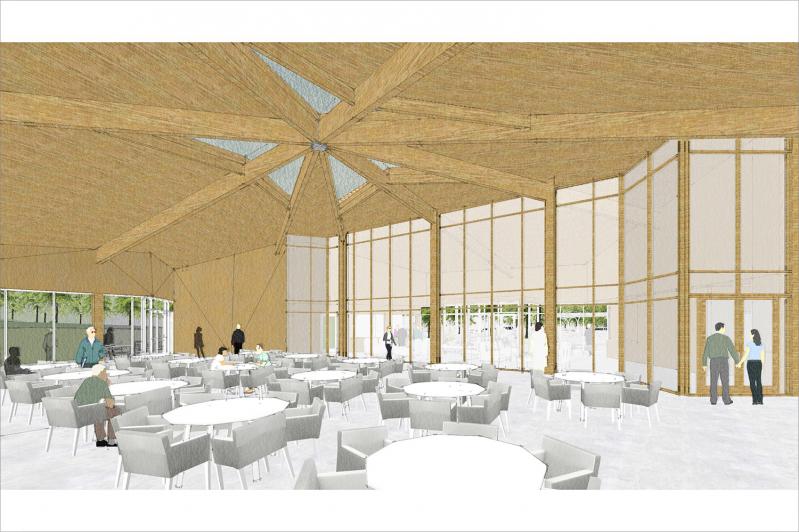A new East Hampton Town senior citizens center on Abraham’s Path in Amagansett took another step toward reality on Tuesday when the architects selected for the project presented updated plans to the town board.
The new center, at around 24,000 square feet, will be more than double the size of the existing senior citizens center on Springs-Fireplace Road in East Hampton, and will host many of the Programs for the Aging classes and activities that East Hampton Town’s Human Services Department announced last month for the growing 60-plus demographic.
Lena Reiff of Ross Barney Architects of Chicago presented several renderings of the new center, the three-wing “windmill” design having been chosen from four options previously presented to the board. A connection to nature and the outdoors is emphasized, as well as activity spaces dedicated to wellness and the arts, a centrally located dining room — “the crown jewel of the center,” she said — that will serve as a hub for social interaction, and a facility that conforms to the town’s goal to achieve all of its energy needs through renewable sources.
The center will be accessed from Abraham’s Path with a driveway to the site just south of the Terry King ball field complex, Ms. Reiff said, leading to a curbless entry under an overhanging roof. Around 65 parking spaces will be situated at the north end of the site, with another 45 for staff on the southern side. Driving lanes will likely be asphalt, but individual parking stalls could feature permeable pavers, she said. The site is in the woods, she said, “and we’d like to keep it as untouched as possible” while minimizing the heat-island effect of asphalt. Solar photovoltaic panels could provide a canopy over portions of the parking areas, she said. (Electric vehicle charging stations are also expected to be incorporated into the plan, Councilwoman Kathee Burke-Gonzalez said later.)
Some of the grounds can be manicured lawn, but the site will emphasize “meadows and pollinator gardens,” Ms. Reiff said, “and beyond that really just having untouched forest. Really, we want to leave as much of this site untouched as possible. It’s a pretty site, it’s in the woods. We want to keep it that way.” Two covered outdoor dining areas are envisioned, as are three walking trails on the site, part of a 14.3-acre parcel.
The goal is to maintain as many of the existing trees on the property as possible, which include eastern white pine and oak trees. Cherry trees along the driveway “could be a really nice entry sequence,” she said, “especially when they’re blooming.”
The three wings of the building will be oriented to senior citizens, staff, and “back-of-house, what-keeps-the-building-running” necessities, Ms. Reiff told the board. Entering the building, visitors could see an open, self-serve cafe with soft seating to their left, she said. A designated game room, an arts and crafts room, a media room, and a wellness room are envisioned, she said. A constant throughout the design is natural light and full views of the surroundings.
New to the design is a glazed partition between the lobby and dining space, allowing a visual sight line between the two spaces despite the physical and acoustical separation.
The building’s exterior is inspired by potato barns on the South Fork, Ms. Reiff said, as well as the shingled structures that are prevalent here. With an accompanying PowerPoint presentation, she presented, as potential options, images depicting reflective metal shingles — “a new take on an old material,” she called it — as well as “sho sugi ban” wood shingles. Also spelled “shou sugi ban,” the Japanese term means “charred cedar board.” It “involves charring cedar planks, then burnishing the burnt wood with wire brushes and sandpaper before sealing it with natural oil,” according to the MasterClass website. The technique “produces blackened, charred wood siding that is resistant to the elements,” making it “appropriate for both interior and exterior applications.”
Of the reflective metal option, Ms. Reiff mused on “how beautiful would it be if you could see the reflection of the entire wooded site on the building, so the building is almost absorbing the site around it.” The latter shingles “are a little bit more of a contrast, a bit more of a statement piece.”
The board was pleased with the presentation, albeit with a few suggestions for minor modifications. “It looks so naturally nestled into that topography” Supervisor Peter Van Scoyoc said. “I think the general layout is evolving in a way that’s very positive.” Councilwoman Cate Rogers said that the plan “best represents, for me, the functionality of what we need in a senior center and the amenities we want to offer.”
Mr. Van Scoyoc said that primary concerns about the building’s exterior are maintenance and longevity. He favored the metal shingles, he said, but “I personally prefer the more muted natural tones of the shingles and wonder if there’s a less reflective” offering akin to the sho-sugi-ban option “which is much more subdued, maybe more natural in its appearance, and doesn’t have a reflective quality. I think marrying the benefits of those two options in the stainless steel would be preferable to me.” Councilwoman Sylvia Overby said that she favors the wood shingle, “but I will keep an open mind.”
Design development will continue for another 16 weeks, the board was told, followed by around 20 weeks of construction documentation, and then a bidding period between February and May of 2024. Construction could then begin and span 18 months, continuing to November 2025.




